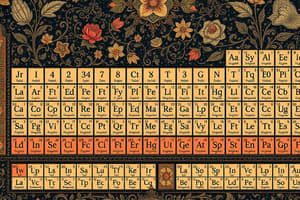Podcast
Questions and Answers
What is the purpose of chemical symbols in chemistry?
What is the purpose of chemical symbols in chemistry?
- To confuse chemists with complicated abbreviations
- To help identify elements with short, standardized abbreviations (correct)
- To represent chemical formulas using lengthy identifiers
- To complicate communication about elements
How are chemical symbols derived?
How are chemical symbols derived?
- From the last letter of an element's name
- From the most common vowel in the element's name
- From the first one or two letters of an element's name (correct)
- From random letters in the element's name
Which organization established guidelines for consistency in chemical symbols?
Which organization established guidelines for consistency in chemical symbols?
- International Union of Pure and Applied Chemistry (IUPAC) (correct)
- International Organization for Standardization (ISO)
- American Chemical Society (ACS)
- United Nations Educational, Scientific and Cultural Organization (UNESCO)
What type of elements are represented by single-letter symbols?
What type of elements are represented by single-letter symbols?
Which element has a two-letter chemical symbol?
Which element has a two-letter chemical symbol?
Apart from letters, what other types of symbols are used for representing elements on the periodic table?
Apart from letters, what other types of symbols are used for representing elements on the periodic table?
Why do some elements like calcium and strontium have two-letter symbols?
Why do some elements like calcium and strontium have two-letter symbols?
What is the significance of the chemical symbol 'H' for hydrogen?
What is the significance of the chemical symbol 'H' for hydrogen?
How did Dmitri Mendeleev contribute to the evolution of chemical symbols?
How did Dmitri Mendeleev contribute to the evolution of chemical symbols?
Why are chemical symbols important in chemistry?
Why are chemical symbols important in chemistry?
What do chemical symbols allow chemists to do?
What do chemical symbols allow chemists to do?
What was the historical reason for the unique chemical symbol of hydrogen?
What was the historical reason for the unique chemical symbol of hydrogen?
Flashcards are hidden until you start studying
Study Notes
The Periodic Table and Its Chemical Symbols
The periodic table, a fundamental tool in the world of chemistry, is a visually organized chart that displays the properties and characteristics of elements. At the heart of this tool are the chemical symbols—simple, unique identifiers that help chemists communicate about elements efficiently. Let's explore this essential aspect of the periodic table in more detail.
Defining Chemical Symbols
A chemical symbol is a short, simple, and standardized abbreviation used to represent an element in chemical formulas, equations, and other contexts. These symbols are derived from the element's name, and they're commonly constructed from the first one or two letters of an element's name.
For example, the chemical symbol for hydrogen is H, the first letter of the word "hydrogen," and the symbol for lithium is Li, the first letter of "lithium."
Design Principles of Chemical Symbols
The International Union of Pure and Applied Chemistry (IUPAC) established a set of guidelines to ensure consistency in chemical symbols. These guidelines include:
- One-letter symbols: Some elements are represented by a single letter, such as H, Li, and Fe (for iron).
- Two-letter symbols: A few elements have two-letter symbols. For instance, the chemical symbol for aluminum is Al, and the symbol for copper is Cu.
- Greek letters and other symbols: The periodic table includes a handful of elements represented by Greek letters and other symbols. For example, the chemical symbol for argon is Ar, and the symbol for carbon is C.
Evolution of Chemical Symbols
The use of chemical symbols dates back to the 16th century when chemists and alchemists began to represent elements with simple, easy-to-remember abbreviations. The modern periodic table, developed by Dmitri Mendeleev in the 19th century, standardized these symbols, making them uniform and consistent across the world of chemistry.
Special Cases of Chemical Symbols
The periodic table includes a few elements with unique chemical symbols due to historical reasons or to avoid confusion. For example:
- Alkaline earth metals: The elements in this group (e.g., calcium, strontium, and barium) have two-letter symbols, where the second letter is "a" (pronounced "ay"). This is to differentiate them from the alkali metals (e.g., sodium and potassium), which have one-letter symbols.
- Hydrogen: The most abundant element in the universe has a unique chemical symbol—H. This is because the first letter of "hydrogen" is also the first letter of "hydrogenate," an essential process in organic chemistry.
The Importance of Chemical Symbols
Chemical symbols serve as an important communication tool in chemistry. They allow chemists to quickly and accurately identify elements in chemical formulas, equations, and other contexts. By understanding chemical symbols, chemists can more easily share information and collaborate on scientific endeavors.
Summary
Chemical symbols are essential tools for chemists, as they allow for efficient communication about elements through simple, standardized abbreviations. The periodic table demonstrates the importance of these symbols, as it organizes and displays elements according to their chemical properties and characteristics. By understanding chemical symbols, chemists can more easily share information and collaborate on scientific endeavors.
Studying That Suits You
Use AI to generate personalized quizzes and flashcards to suit your learning preferences.




